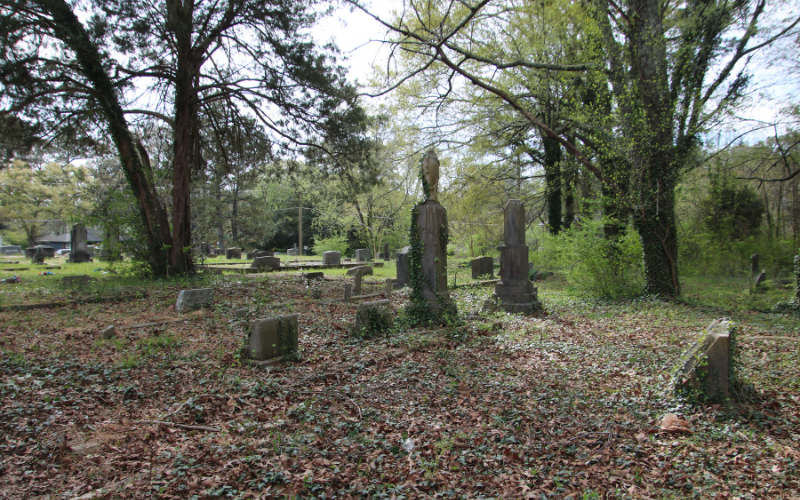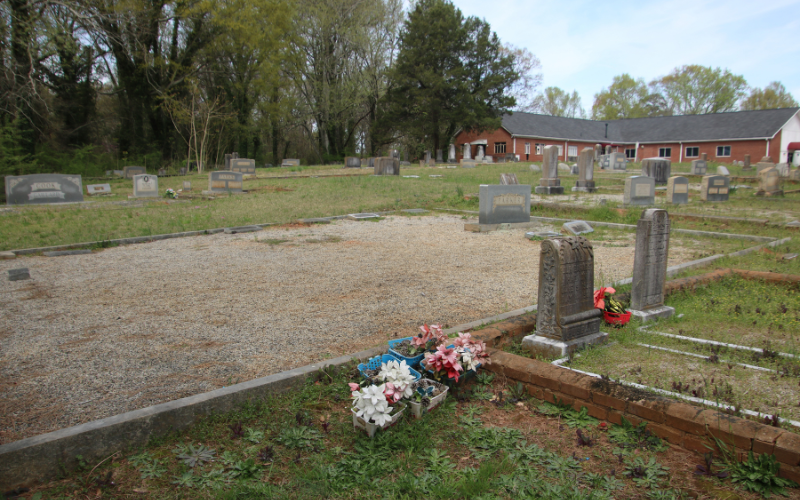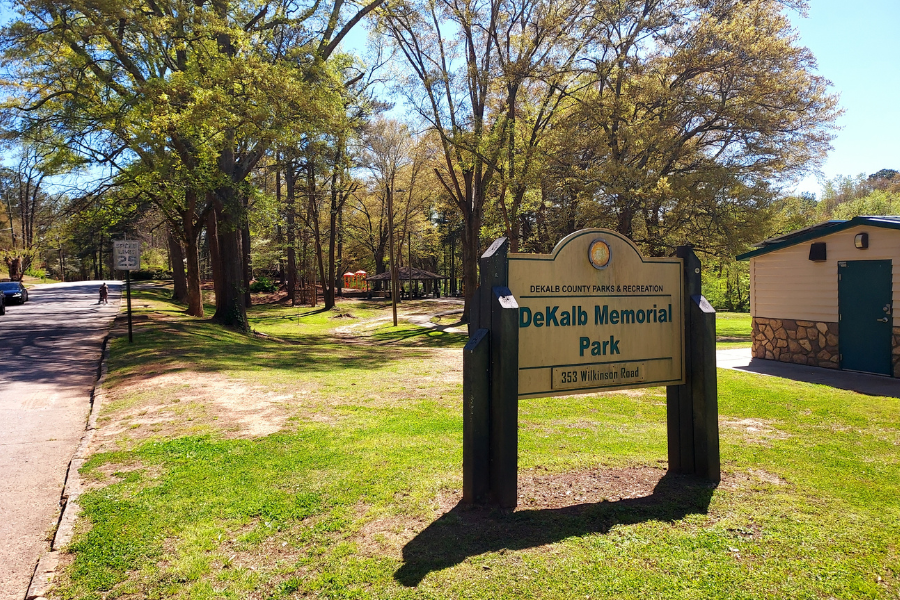Family Cemeteries, Inherited Responsibilities
An inherited responsibility for ancestors and community. What happens to Family Cemeteries for the next generation?
By Claudia Stucke, DHC Volunteer
Photos By Jay Bradley Terrell
Every time a relative or family friend died, my mother took me to the deceased’s visitation, funeral, and the interment that followed. She was one of nine children, and my father was one of twelve; and since the twenty-five-year difference in their ages put one side of the family a full generation ahead of the other, my visits to church graveyards and family cemeteries were many and among my earliest childhood memories. They were always the same: acres of green space with rows of granite or marble tombstones of varying sizes–mowed, well-kept, sometimes by church volunteers or employees, but most often kept up by family. Graves of loved ones interred in a church graveyard were easily tended on Sundays after church; but all received special attention on birthdays, anniversaries, or holidays, along with seasonal flowers or a little U.S. flag. Sometimes a cemetery-tending would follow the annual church homecoming celebration–a special church service, a welcome to former pastors and former members, and the communal potluck picnic “dinner on the grounds.”

I never heard anyone complain about or question their own duty to the departed. Every now and then an adult would comment about the weeds growing near Grandpa’s or Aunt So-and-So’s grave and how somebody ought to do something, and then “somebody” would load a lawn mower into a pickup truck or car trunk and take care of it. And it was no more trouble to groom the nearby gravesite of a relative if need be. It’s just what they did.
But younger generations have grown up and moved away, and church congregations have diminished or disappeared altogether, leaving these once-sacred duties to . . . whom?

The church of my early childhood, Stamps Chapel Baptist, was built on land donated by J. L. Stamps in 1904; but the Parker Family Cemetery, whose boundaries abut the church grounds, predates the church, with some gravestones dating back to the late 1800s. Like many other churches in DeKalb County, Stamps Chapel has changed ownership and congregations several times since its establishment. Although many—if not most–of the people buried there appear to have been members of Stamps Chapel, the various plots were deeded to individuals and families; and their descendants have—perhaps unknowingly—become the owners of the burial grounds.

One positive—and quite unexpected—example of responsibility came from a resident of another state, who expressed concern about this cemetery, where some of her relatives are buried. When visiting DeKalb County, she saw the condition of the cemetery and called to ask the History Center if it might be in danger of being sold to a developer. Even though she was reassured that burial grounds are protected under Georgia law, she personally made a trip to the History Center, joined, and contacted a landscape worker to clean up her family’s portion of the cemetery. We are inspired by and grateful for her example.

Several other relatives and I have visited the cemetery from time to time to determine what it needs and what is within our financial and physical means to do so. As we get older and less able to do heavy manual labor, we look to younger generations to assist. This has become increasingly difficult, as so many folks have moved away from the area, and, as noted above, most may be oblivious to any connection to these generations of relatives or any responsibility for their final resting place. Ideally, we would connect to more local relatives, assess conditions, distribute tasks, collect funds if needed, and generally share collective responsibility.
But however we may feel about a sense of duty to those who came before us, we must also acknowledge the cemetery’s impact on the community. Recent visits to the cemetery have revealed a variety of conditions, from well-kept to neglected and overgrown. Fortunately the street frontage area is reasonably well-maintained—a particularly good thing for the adjacent church, whose congregation must see this sight at least weekly, and for the surrounding community, whose residents have to live only yards away from it, well-kept or weedy. But farther back, English ivy and other plants have obscured markers and created tripping hazards as well as snake-friendly habitat.

Our attempts at assessing next steps have been complicated by further questions:
- How do we get in touch with people whom we’ve lost touch with or whose names we may not even know?
- It is not known at this time which cemetery lot deeds, if any, were properly recorded, which may complicate the chain of inheritance. And even if we are clearly the owners by inheritance, as individuals, we are not heir to any of the land except those plots for our direct ancestors. Do we have right of ingress/egress, or are we liable for trespass?
- And as to liability, if we can find and engage friends and family members to assist in clearing and maintaining, or if we hire people to do maintenance work, are we liable for injury (falls, snakebite, etc.) to them? Are we liable for property damage if our mowing or weed-cutting equipment damages memorial markers (many of which are soft marble)?
It has been suggested that we form a nonprofit organization and keep a certain amount of money in an account for maintenance. Again, the question of responsibility arises: Who contributes? Whose gravesites benefit, everyone’s or just those whose descendants have been identified and contribute? And how do we keep the organization up and running from one generation to the next? Even with this option, we find ourselves asking the same questions.
Late last year a small (but heavy) tree fell across two or three graves of people whose names I did not recognize. I had no idea how to get in touch with the families of those buried there, either to ask their help or to ask their permission to move the tree. Several of our family members met to make a plan to remedy the issue, and I created a Facebook page to raise awareness and solicit assistance and posted photos. (To date, this group still has only eleven members, so I don’t know how successful it is or will be.) But when we visited the site to take more photos, we discovered that the tree had been removed, and all that remained was a stump. Fortunately, the graves and markers appeared undamaged. And farther back in the cemetery another tree, which we had identified as dead and in danger of falling, had also been removed. Although I posted before-and-after photos on Facebook, expressed our gratitude, and asked the person(s) responsible to identify themselves, we still do not know who took the initiative and did this work. Thank you again, whoever you are.
We know that other extended families, communities, and houses of worship are faced with similar challenges. It is a common problem–a drive through DeKalb County will take you past several burial grounds that are in need of care. We see examples in local news: they receive attention for a while, and then nothing happens. Meantime, we continue to look for answers, find connections, solicit assistance, and reduce the physical and financial demand by way of joining together to solve this complex problem.






